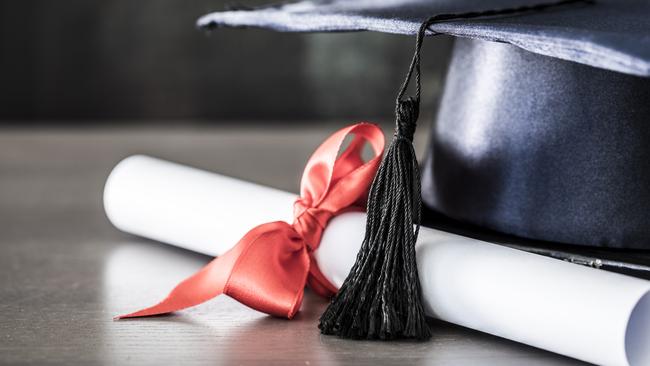Universities set low bar to take subpar students
Struggling students who left school at the bottom of the class are being accepted into prestigious university degrees including engineering, architecture and psychology.

Struggling students who left school at the bottom of the class are being accepted into prestigious university degrees including engineering, architecture and psychology.
Universities made offers to students with Australian Tertiary Admission Rank (ATAR) scores below 50 – the bottom 10 per cent of high school leavers – for 221 different bachelor degrees this year, placing them at higher risk of failure and financial risk.
The revelation of the low bars being set for academic entry comes as the federal government cracked down on cheating by blocking 40 of the most visited academic cheating websites on Friday.
Federation University Australia, the University of Tasmania, and La Trobe University both accepted students with an ATAR in the 30s – the bottom two per cent of school leavers.
Aspiring teachers can access seven different education degrees with ATAR scores 50 and below, sparking protests from the teachers’ union on Friday.
Australian Education Union president Correna Haythorpe warned that students with an ATAR lower than the average of 70 were likely to fail a teaching degree.
“Low university-entry scores for teaching degrees is a growing concern,’’ she said.
“Evidence suggests that students admitted with low ATARs are likely to be less successful at university and are less likely to complete their course.
“The bar must be raised by setting minimum entry requirements and making teaching a two-year postgraduate degree.’’
A Federation University spokeswoman blamed an “administrative error’’ for admitting a student with an ATAR of 37 to a teaching degree this year.
“We have investigated this matter with the Victorian Teaching Institute, and we are both satisfied that the student is doing well and should be allowed to complete the course,’’ she said.
Alarmingly low academic requirements are revealed in ATAR cut-off scores for university admissions this year, published on the federal government’s Course Seeker website using official data from universities and tertiary admission centres. Starting this year, students who fail to pass at least half their subjects will lose taxpayer subsidies and be forced to pay the full cost of their degree, switch to an easier course or drop out of university.
The federal Education Department said it did not yet know how many students were failing, and losing taxpayer funding, as a result of the former Coalition government’s Job-Ready Graduates legislation that will be reviewed by the new Labor government later this year.
If students fail a course and are kicked out, they will still have to repay the student loans they borrowed through the Higher Education Loan Program (HELP), possibly leaving them with a lifelong debt.
“For a bachelor degree the rule applies if a student does not complete or fails more than 50 per cent of at least eight units until the end of the degree,’’ a spokesperson said.
“If this occurs students lose access to Commonwealth Supported Places (government subsidy) and to HELP. They can regain access by changing to another course that, for example, might better suit them.
“If a student has failed or not completed units because of illness, or other unusual stresses or things out of their control in their life, their university can exempt those units from the rule.’’
Federal Education Department data shows that more than 13,000 students with below-50 ATAR scores applied for university last year, with 55 per cent accepted.
Another 30,000 students applied with ATARs between 50 and 70, with three-quarters accepted, while nearly all the 29,000 applicants with an ATAR above 90 enrolled in a degree.
Of the students with low ATAR scores, 11 per cent were from poorer backgrounds while only 2 per cent were from wealthy families.
Among the highest achievers, 38 per cent were wealthy and 17 per cent were from poorer families.
Higher education policy expert Andrew Norton, professor in the practice of higher education policy at the Centre for Social Research and Methods at the Australian National University, warned that students admitted with low academic results were the most likely to drop out of university.
He said half the students with an ATAR below 50 would fail to complete their course.
“Often they are equity students admitted under special arrangements,’’ he said.
“Nevertheless, they are coming in with what looks like poor academic preparation.
“I am concerned that some students will be expose to financial risk because they have a high chance of not completing their degree.’’
Federal Education Minister Jason Clare revealed the Tertiary Education Quality and Standards Agency (TEQSA) had blocked 40 cheating websites. Students had used the websites to buy essays or assignments, or pay someone to sit exams on their half.
Mr Clare said the 40 websites had been visited 450,000 times a month. “Illegal cheating services threaten academic integrity and expose students to criminals, who often attempt to blackmail students into paying large sums of money,’’ he said.
“Blocking these websites will seriously disrupt the operations of the criminals behind them.’’
University Australia chief executive Catriona Jackson said that “contract cheating” threatened the integrity of a university education.
“It is bad for universities and students, and any action to stop these ruthless outlets is a good thing,’’ she said.
The Course Seeker data shows that the University of Tasmania admitted business graduates with an ATAR of 30 this year, while RMIT University set a low threshold of 48.4 for its Bachelor of Psychology.
While the University of NSW accepted only students with an ATAR over 85 for its civil engineering degree, La Trobe University lowered its cut-off to 50.
For an accounting and finance degree, the Australian Catholic University set a cut-off barely below 50, while the University of Tasmania admitted architecture students with an ATAR of just 44.
Federation University Australia this week scrapped its Bachelor of Arts degree, blaming a drop in student enrolments.
“The ongoing COVID-19 pandemic has caused a significant decline in international enrolments, and we are now in our third year of declining student enrolments,’’ acting vice-chancellor Wendy Cross said on Friday.
“We have also seen a drop in domestic student enrolments generally due to online learning fatigue that continues to significantly impact the university’s financial position.”
National Tertiary Education Union Victorian assistant secretary Sarah Roberts said an arts degree was a “bedrock offering for all universities’’. “This is a demoralising day for humanities in Victoria (and) a hammer blow for students who live regionally and want to study arts,” she said.
An ACU spokeswoman said the lowest “raw ATAR” for its accounting course was 49 for one student whose ATAR was adjusted to meet the published cut-off of 58.5.
“It does not mean that there are other students accepted with that as a raw ATAR in that course,’’ she said.
“There are many cases where circumstances such as domestic violence, sudden illness, mental health, etcetera, affect final exam results and ATAR.
“These students would have missed a university education without adjustment factors.”








To join the conversation, please log in. Don't have an account? Register
Join the conversation, you are commenting as Logout